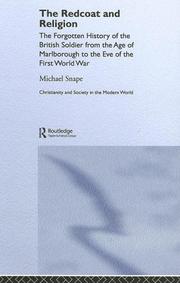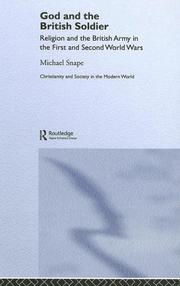| Listing 1 - 4 of 4 |
Sort by
|

ISBN: 0415377153 9780415377157 Year: 2005 Publisher: London Routledge
Abstract | Keywords | Export | Availability | Bookmark
 Loading...
Loading...Choose an application
- Reference Manager
- EndNote
- RefWorks (Direct export to RefWorks)
This compelling study presents the most comprehensive examination available of the role of religion in the army during the eighteenth and nineteenth centuries. Through extensive analysis of official military sources, religious publications and personal memoirs, Michael Snape challenges the widely-held assumption that religion did not play a role in the British Army until the mid-Victorian period, and demonstrates that the British soldier was highly susceptible to religious influences long before the Crimean War and Indian Mutiny rendered the subject of wider public concern. In' The Redcoat and Religion' Snape argues that religion was of significant, even defining, importance to the British soldier and reveals the enduring strength and vitality of religion in contemporary British society, challenging the view that the popular religious culture of the era was wholly dependent upon the presence and activities of women. Students of British history, military history, and religion will all find this an insightful resource for their studies.
Soldiers --- -253:355 --- Armed Forces personnel --- Members of the Armed Forces --- Military personnel --- Military service members --- Service members --- Servicemen, Military --- Armed Forces --- Religious life --- -History. --- Pastoraal voor soldaten, militairen. Legeraalmoezeniers --- Great Britain. --- Angliǐskai︠a︡ Armii︠a︡ --- Tsava ha-Briṭi --- British Army --- בריטניה. --- צבא הבריטי --- England and Wales. --- History. --- 253:355 Pastoraal voor soldaten, militairen. Legeraalmoezeniers --- 253:355 --- Religious life&delete& --- History

ISBN: 0415196779 9780415196772 0415334527 9780415334525 Year: 2005 Publisher: London Routledge
Abstract | Keywords | Export | Availability | Bookmark
 Loading...
Loading...Choose an application
- Reference Manager
- EndNote
- RefWorks (Direct export to RefWorks)
Historians of the First and Second World Wars have consistently underestimated the importance of religion in Britain during the war years. Through a study of the experience of the officers and men of Britain's vast citizen armies, and also of the numerous religious agencies which ministered to them, this book shows that religion had much greater currency and influence in twentieth-century British society than has previously been realized. Drawing on a wealth of new material from military, ecclesiastical and secular civilian archives, Snape argues that religion provided a key component of military morale and national identity in both the First and Second World Wars, and demonstrates that, contrary to accepted wisdom, Britain's popular religious culture emerged intact and even strengthened as a result of the army's experiences of war.
Soldiers --- World War, 1914-1918 --- World War, 1939-1945 --- Religious life --- History --- Religious aspects. --- Great Britain. --- Religious life. --- Great Britain --- Religion --- -World War, 1939-1945 --- -Soldiers --- -253:355 --- 253:355 Pastoraal voor soldaten, militairen. Legeraalmoezeniers --- Pastoraal voor soldaten, militairen. Legeraalmoezeniers --- Armed Forces personnel --- Members of the Armed Forces --- Military personnel --- Military service members --- Service members --- Servicemen, Military --- Armed Forces --- European War, 1939-1945 --- Second World War, 1939-1945 --- World War 2, 1939-1945 --- World War II, 1939-1945 --- World War Two, 1939-1945 --- WW II (World War, 1939-1945) --- WWII (World War, 1939-1945) --- History, Modern --- European War, 1914-1918 --- First World War, 1914-1918 --- Great War, 1914-1918 --- World War 1, 1914-1918 --- World War I, 1914-1918 --- World War One, 1914-1918 --- WW I (World War, 1914-1918) --- WWI (World War, 1914-1918) --- -History --- -Pastoraal voor soldaten, militairen. Legeraalmoezeniers --- -Religious life. --- -World War, 1914-1918 --- 253:355 --- Religious aspects --- Angliǐskai︠a︡ Armii︠a︡ --- Tsava ha-Briṭi --- British Army --- בריטניה. --- צבא הבריטי --- England and Wales.
Book
ISBN: 9781843838920 1843838923 9781782044857 9781783275045 Year: 2015 Publisher: Woodbridge: Boydell and Brewer,
Abstract | Keywords | Export | Availability | Bookmark
 Loading...
Loading...Choose an application
- Reference Manager
- EndNote
- RefWorks (Direct export to RefWorks)
America's armed forces played a critical part in the defeat of Hitler's Germany and made by far the biggest contribution to the Allied defeat of Japan. In the US, military veterans of World War II are widely revered as the foremost representatives of 'the greatest generation', a generation that vanquished fascism in Europe and the Far East, faced down the threat of communism during the Cold War, and achieved unprecedented levels of prosperity and social mobility in their own society. Elsewhere, America's service men and women are often remembered more ambivalently for their material abundance, their hedonism, and even their rapacity. God and Uncle Sam shows that both perspectives are problematic: America's armed forces were the products of one of the most diverse and dynamic religious cultures in the western world and were the largest ever to be raised by a professedly religious society. Despite constitutional constraints, a pre-war 'religious depression', and the myriad pitfalls of war, religion played a crucial role in helping more than sixteen million uniformed Americans through the ordeal of World War II, a fact that had profound and far-reaching implications for the religious development of post-war America. This timely and authoritative book draws on meticulous research in US archives and is informed by contemporary films, photographs, posters, and sound recordings.
World War, 1939-1945 --- Religious aspects --- United States --- Armed Forces --- Religion
Article
Abstract | Keywords | Export | Availability | Bookmark
 Loading...
Loading...Choose an application
- Reference Manager
- EndNote
- RefWorks (Direct export to RefWorks)
| Listing 1 - 4 of 4 |
Sort by
|

 Search
Search Feedback
Feedback About UniCat
About UniCat  Help
Help News
News